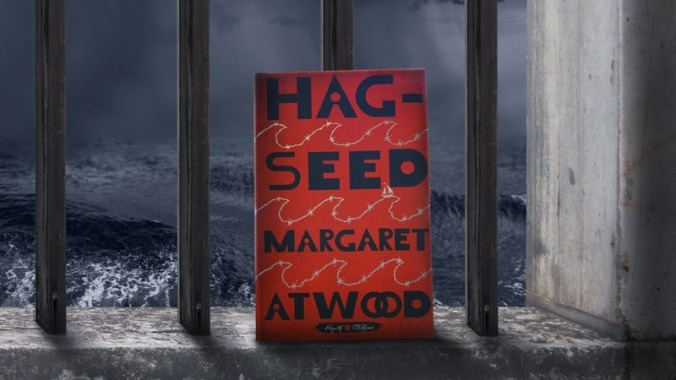What you’re gonna see, is a storm at sea:
Winds are howlin’, sailors yowlin’,
Passengers cursin’ ’em, ’cause it gettin’ worse:
Gonna hear screams, just like a ba-a-d dream,
But not all here is what it seem,
Just sayin’ …
Now we gonna start the playin’.
You might think that this is a cheap or easy way to adapt The Tempest but, as the announcer says at the very beginning: not all here is as it seems. There are layers upon layers of The Tempest woven throughout the plot of Hag-Seed, as we see just pages later when we meet Felix Phillips, the director of the Fletcher Correctional Players. We quickly learn that he used to be the artistic director of the prestigious Makeshiweg Festival before being disgraced and deposed by his colleague and rival, Anthony. Felix goes into self-imposed exile, taking a new name, Mr. Duke, and during his 12 years of reclusive living imagines that his daughter, Miranda, who died of meningitis at the age of 3, is living with him. This parallels the plot of Shakespeare’s play, in which Prospero, the duke of Milan, is overthrown by his brother Antonio, and set adrift in a leaky boat with his daughter Miranda until they come to the shore of an enchanted island. (If you need to brush up on your Tempest, Atwood thoughtfully includes a summary chapter at the end of the book.)
Felix has a history of adapting Shakespeare’s plays in highly creative ways—a “freely bleeding Lavinia in Titus,” a Pericles with spaceships and aliens, and, in A Winter’s Tale, a Hermione who returns to life as a vampire. And just before Anthony’s power play forces him out of the Makeshiweg Festival, Felix is planning an elaborate production of The Tempest. He wants it to be magical in more ways than one—he wants to use it to bring some aspect of his dead daughter back to life: “Lavinia, Juliet, Cordelia, Perdita, Marina. All the lost daughters. But some of them had been found again. Why not his Miranda?”
So after 12 years of living alone and following Anthony’s career from a distance, Felix takes a job directing a group of inmates at the Fletcher County Correctional Institute, certain that an opportunity for revenge will come. And when it does, he decides that it is time for him to stage The Tempest, a play about revenge, restoration, and return all at once.
While there are some wild moments in Hag-Seed, Atwood’s writing is so skillful that it is easy to suspend our disbelief. It also helps that so much theater is involved—we become used to articulate and expressive characters and fortuitous plot twists. One of the greatest pleasures of the book comes from one of the rules Felix sets out for his inmate actors: They can only use curse words from the play they are producing. “Whoreson … Malignant thing … Thou earth. Thou tortoise. Thou poisonous slave … Hag-seed … Pied ninny. Scurvy patch.” Which leads to such excellent exclamations as “Scurvy awesome!” and “Way to red plague go!” and “What the pied ninny is this?”
Another pleasure is being uncertain how the book will end—even if you know how The Tempest ends. Will The Fletcher Correctional Players perform the play? Will it help Felix get his revenge? Will it bring some version of Miranda back? The post-play reports that the actors are assigned help to keep the suspense—each one imagines the fate of their assigned character after The Tempest is over. Will Prospero be happy as reinstated Duke? What will Ariel do with his freedom? And what will happen to Caliban? The actors/inmates come up with surprising futures for their characters—some happy and some violent—and these possibilities make us wonder: Will any of these happen to Felix?
Only the title of the book remains a bit of a puzzle. Hag-seed is one of the nasty things that Prospero calls Caliban, an often-violent half-human creature who inhabits the island, and it makes the reader expect the book to be more about him. Caliban does get some good musical numbers in the Fletcher production of Tempest, but Hag-Seed is mostly about Felix-as-Prospero. Still, Caliban’s imagined afterlife sheds some light on Felix and the inmates’ possible futures, so perhaps the title is meant to call attention to that shift, which adds one last layer of The Tempest across Atwood’s brilliant tale, taking it past the last pages of the book and allowing it to linger in our minds even as we close its back cover.
Purchasing Hag-Seed via Amazon helps support The A.V. Club.

